All items shown are authentic
most items are part of Brother Thomas Felice’s Private Collection
except a couple listed as "IBT Archives"
|
Teamsters declared by proclamation at the 1916 Convention that the horse would always be the heart of the union and always remain a part of any badge, button, logo or flag
.
Tobin saw that technology was radically changing the freight-moving industry. Recognizing the trend and to motorization as more than a passing fad, he set out to organize the fast-growing motorized truck delivery industry. He began by organizing motor truck drivers and prevailed on horse and wagon companies to train their drivers in automotive skills. In 1912, Teamsters were part of the first transcontinental delivery of goods by motor truck. The wave of the future was obvious to even the most die-hard traditionalists, and Teamsters had secured themselves a place as leaders of the transition.
.
For several years, trucks and horses worked some of the same jobs: Teamsters at the reins and at the wheel. Desperate to compete with the new motor carriers, horse-drawn freight firms tried to save money by eliminating feedings for Teamsters horses. Teamsters responded by striking, winning important safeguards for their animals’ well-being. As further proof of their devotion to their loyal partners, even amid the many changes, Teamsters declared by proclamation at the 1916 Convention that the horse would always be the heart of the union and always remain a part of any badge, button, logo or flag.
|
Extremely Rare
Teamster Stagecoach Driver
Tin Type Photo
|
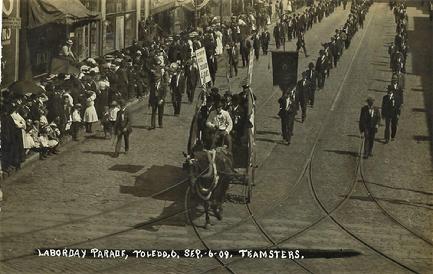 |
| Click to enlarge |
|
|
| 1913 Three Rivers Michigan Teamsters Strike |
These items were acquired from the late Larry Buchan’s collection. Larry spent most of his working career with the Canadian Pacific Railway from November 1965 until November 2002. He was an engineer for CPR out of Calgary and it was known as BLE at the time. He was active in the union an was a delegate to the convention in Cleveland.
.
He was forced to retire due to an accident. While on a bus tour of North and South Dakota in November 2000 a bad winter storm formed leaving Buffalo, North Dakota and the bus he was on rolled over. He ended up head-first into the luggage carrier, which resulted in him becoming a quadriplegic, hence the name Broken Rail. This ended his 22-year career on the CPR, working as a locomotive engineer in Alberta, Saskatchewan, and British Columbia.
.
Those, who knew Larry, were amazed at how he embraced being disabled. He started a website Railwayearth.com. Larry passed in August of 2021. RIP Brother.
|
Team Drivers & Team Owners leather and brass bridle tack
|
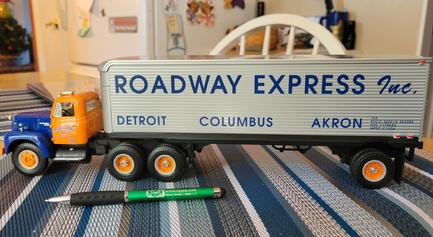 |
| Vintage Roadway Truck from Brother Vince Zvorsky |
|
|
| Tin Type Photo - Very Early Teamster Freight Haulers |
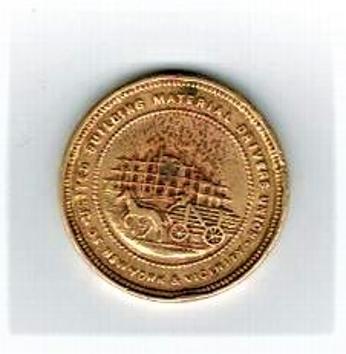 |
| Building Material Drivers New York City |
|
|
Daniel Joseph Tobin (April 1875 – November 14, 1955) was the General President of the International Brotherhood of Teamsters from 1907 to 1952. From 1917 to 1928, he was secretary-treasurer of the American Federation of Labor
|
| Union Service Teamsters Cribbage Set 1940-JC# 34 Dave Beck |
Items Acquired from Brother Tom Fallon, Teamsters Local 863, NJ. Brother Fallon, now retired, was a Trustee and 20-year steward
|
GENERAL DRIVERS AND HELPERS LOCAL UNION NO. 823
General Drivers and Helpers Local Union No. 823, affiliated with the International Brotherhood of Teamsters, Chauffeurs, Warehousemen and Helpers of America (Campbell '66' Express, Inc.)
.
THE CAMPBELL “66” STORY
.
Campbell 66 Express was founded by Franklin George Campbell in 1926 in Springfield, Missouri. Originally started as Campbell Fuel & Transfer it became Campbell 66 Express, Inc. when a local banker asked Frank if he would take over Rapid “66” Express, a truck line operating down Route 66 from St. Louis to Springfield. It was 1933.
.
In 1935 the Interstate Commerce Act was passed regulating trucking in the U.S. This Act in effect regulated nearly every aspect of transportation by truck. Those truck line operators who could prove they had provided regular service between cities were awarded authority to continue that service. In other words, their proven authority was “Grandfathered”. To gain new authority one had to prove that service was inadequate by the existing carrier. This was very difficult to prove before the Interstate Commerce Commission. It was far easier to buy out another truck line that could connect with your authority by proving to the Commission that you were financially fit and able to take over the line and improve service to the shipping public. For over a period of 40 years, Frank Campbell purchased a number of truck lines expanding his operation from a small line operating in Missouri on Route 66 to operating in 26 states primarily in the Midwest and Southern part of the U.S.
.
This pattern of expansion by the major truck lines came to an end with the passing of the Deregulation Act of 1980. For 45 years the regulated trucking industry had operated under strict regulation and the new Act was such a drastic change that many vanished. Campbell “66” was one of many that disappeared. In 1986 after 60 years the Company declared bankruptcy and its status as a Missouri Corporation was ended in 1997.
.
The telling of the Campbell “66” Story is important not only for its unique 60-year history, but for recognizing the many people who worked for the Company dedicating their working lives to live up to the Company Motto, “Humpin’ to Please”.
|
Although this wagon drivers log book is in extremely poor condition, it is still unique since it is a wagon driver log book from 1869.
|
 |
| 1960's Teamsters pin |
|
|
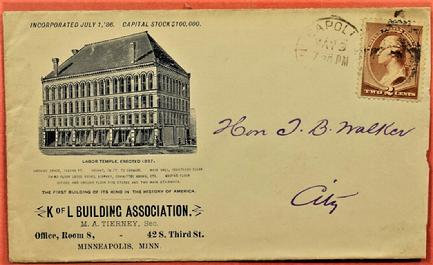 |
| Knights of Labor Building Association |
|
|
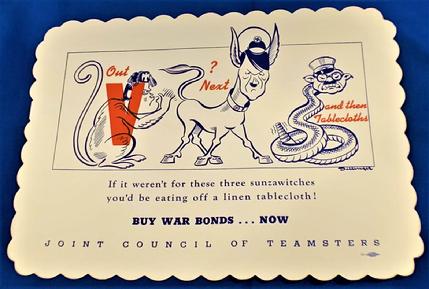 |
| WWII WAR BOND TEAMSTERS JOINT COUNCIL |
|
|
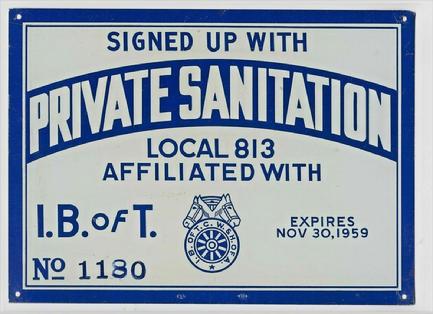 |
| Vintage 1950's Teamster Tin Sign |
|
|
The Chicago Teamsters Strike of 1905
.
What became the deadly Chicago Teamsters strike began as a strike by a small group of fabric cutters as a protest against their employer, Montgomery Ward & Company, hiring subcontractors who were not union members. The company responded by locking out the remaining union workers, and several other unions struck in protest. By April 1905, four months into the strike, over 5,000 workers had walked off their jobs. That month the Teamsters joined in as a sympathy strike, targeting Ward’s and their rival Sears Roebuck and Company, adding another 10,000 workers to the picket lines.
.
Ward’s attempted to use strikebreakers across the picket lines, and violent clashes between strikers, strikebreakers, and local police and hired security personnel became frequent. By May, both sides and the authorities were exchanging gunfire and beatings when they collided. The Employers Association of Chicago (EA), which had long resisted attempts at unionization of companies in the region, was determined to use the strike as the means of breaking the Teamsters Union. Pressure was exerted on the railroads to use workers other than Teamsters to drive the wagons which transported goods to the train stations.
.
An effort negotiated by the Teamsters to end the strike by hiring back the striking garment workers was blocked by the EA and the Teamsters called a general strike, which shut down groceries, coal distribution, shipping, and other critical industries. Court injunctions ordering the strikers to return to work were widely ignored. Violence spread across Chicago and other communities. President Theodore Roosevelt refused to intervene to end the strike.
.
At least 21 deaths and more than 400 people injured were caused by the strike.
|
Hawaii labor nonprofit Unity House shuts down after nearly 70 years
Unity House Inc., a nonprofit organization founded nearly 70 years ago by the late legendary labor leader Art Rutledge to benefit Hawaii union members and their families, closed its doors last month after dissolving the organization.
.
The organization filed articles of dissolution with the state Department of Commerce and Consumer Affairs on July 31, and closed its office at 1701 Ala Wai Blvd. at the end of August, said Jim Boersema, who was the organization’s chairman.
.
Unity House had owned the building on Ala Wai Boulevard from the ‘80s until late 2014, when it was sold to former First Hawaiian Bank CEO Don Horner’s Malu Investments for $2.1 million. Unity House leased back its space, but then Horner sold the property to Japanese investors for $5.7 million in a deal that closed on July 1.
.
Unity House was founded in late 1951 by Arthur Rutledge, who at one time headed both Hawaii locals for the International Brotherhood of Teamsters and the Hotel Employees and Restaurant Employees unions. Rutledge died in 1997 at age 90.
.
Boersema told Pacific Business News that Unity House hadn’t received any income from members since the 1990s. Back in the ‘70s and ‘80s, Teamsters Local 996 and Unite HERE Local 5 members, retirees and their families had paid dues of as little as $1 a month to Unity House, he said.
|
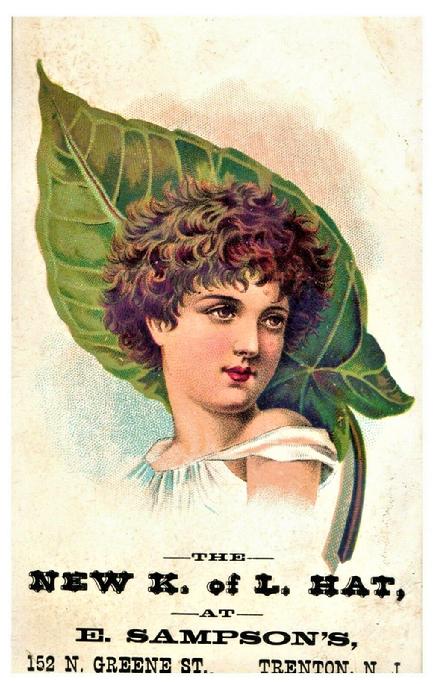 |
| 1880's Uriah Stephen's Knights of Labor Hat E. Sampson Victorian Trade Card |
|
|
|